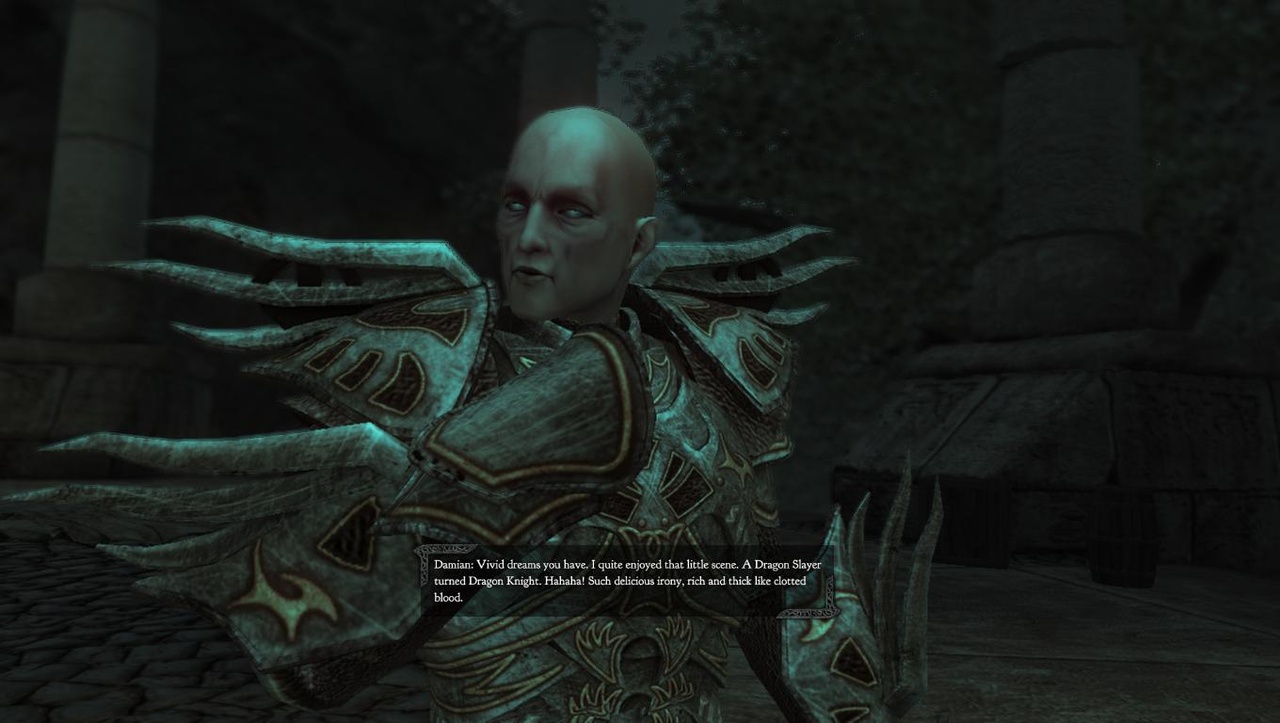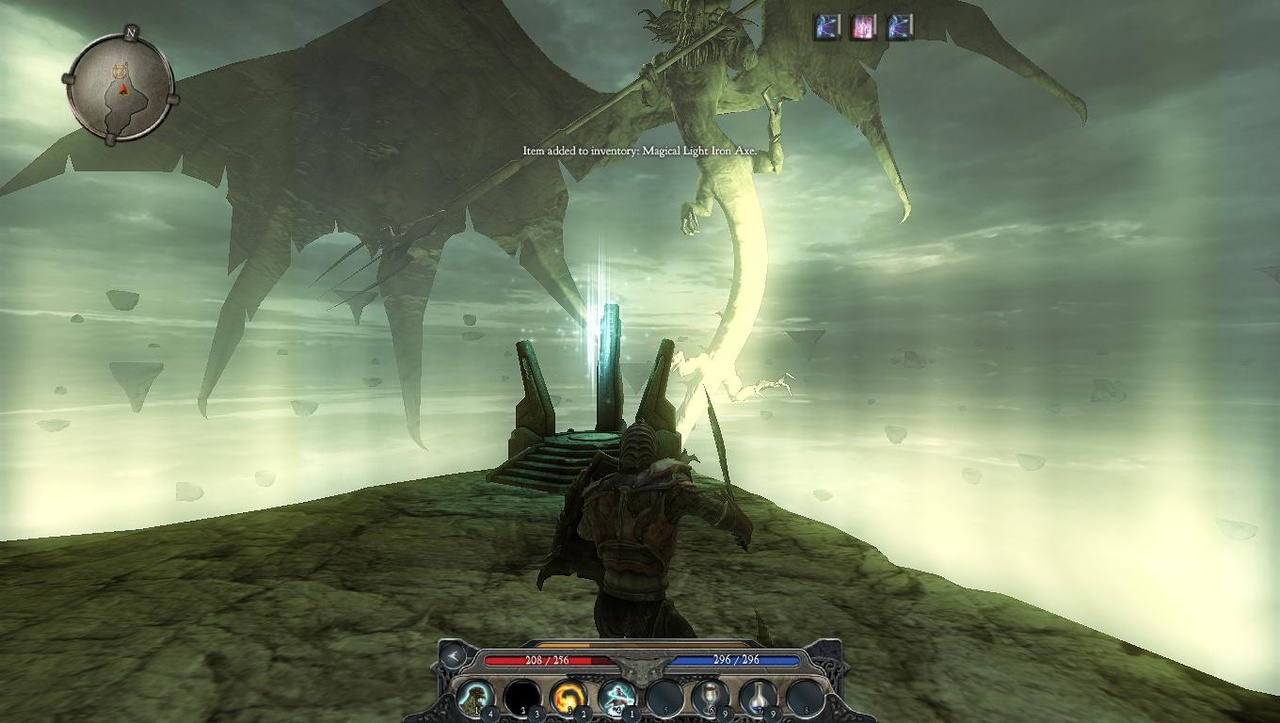In Divinity II, the hunter becomes the hunted. You begin this third-person role-playing game as a newly recruited dragon slayer, eager to join a bloodthirsty party tracking down a fearsome lizard. Soon, however, a turn of events transforms you into what you once reviled: a dragon knight who can slice through enemies on the ground as well as transform into a winged beast and take to the skies. The ability to morph back and forth between human and dragon form is Divinity II's best and most interesting feature, though there are a few other elements that also help set it apart from the competition. Unfortunately, these flames of originality are too often extinguished by Divinity II's less compelling facets. This adventure is a hefty challenge, but the difficulty too often stems from imbalanced enemy encounters rather than tough, thoughtfully constructed battles. Furthermore, thin characters and a by-the-numbers plot make it difficult to get invested in the story. Divinity II may satisfy your craving for some looting and leveling in a fantasy world, but it lacks the sparkle and cohesion of the better games in the genre.

Divinity II makes a good first impression. The initial areas are sunny and bright, and the first major town you visit has a nice fantasy ambience that's just off-kilter enough to avoid looking generic. This is Rivellon, the same world in which the first two games in the series--Divine Divinity and Beyond Divinity--took place, though you don't need to be familiar with them to follow along here. You play a dragon slayer recruit, still in the process of the initiation stages, when you stumble upon a dragon knight in her final death throes. She transfers her powers to you, you meet a bearded sorcerer wearing a big floppy hat covered with stars, and before you know it, you're a dragon knight yourself. It seems that dragons are not the real enemy; rather, the scowling, monologue-loving, bald-headed Damian has returned to the realm and is gathering a powerful army. But Zandalor, the aforementioned wizard stereotype, has a plan: infiltrate the Hall of Echoes, where the dead slumber, and revive Damian's lover, Ygerna. Due to the powerful magic that connects their souls, doing so will in turn trigger Damian's death.
It's a good premise, but the game does a poor job of making you feel connected to the events that unfold. The transformation from slayer to knight could have made an impact, but scant character development and minimalist dialogue siphon away any potential dramatic tension. Some talented voice actors give their lines energy and enthusiasm, but they're rarely given anything interesting to say, and key characters are simple cliches without much personality of their own. And even should you somehow become caught up in the struggle against Damian and his allies, the disappointing ending will let the wind out of your sails. Nevertheless, there are some clever delights scattered about Rivellon, and Divinity II is best when its tongue is planted firmly in cheek. A quest to stop a troll infestation eventually leads you to a roomful of clucking chickens; you solve a riddle filled with enough silly sexual double entendre to make even the most jaded player titter; and the creature you summon to your side stops from time to time to lift his leg and empty his bladder.

In the first hour you'll be asked to choose one of three classes, but don't give this decision too much consideration: Divinity II features a classless skill progression system and provides a good number of different skills to learn in multiple categories. Weapons and magic skills are what you'd expect to see in a fantasy game. Whether you prefer bows or axes, fireballs or magic missiles, you'll find something to your liking, and the steady flow of new goodies will keep loot lovers happy. The early hours, in which you seek out the objects and knowledge that allow you to take your dragon form, send you across sun-drenched fields and into a looming tower. In time you explore goblin-infested caves, mysterious mines, a beach littered with whale carcasses, and a zeppelin port, among other locales. The technology powering Divinity II is not cutting edge; animations are clumsy, textures are bland, and oddities like boulders that aren't flush to the ground and buildings that disappear when you move the camera betray a certain awkwardness. Yet there are some attractive vistas to ogle, and there is a nice amount of visual variety to the dungeons. The art design is familiar but lovely, masking the technical flaws with flourishes of ivy, the deep red glow of molten lava, and shafts of golden light.
It takes a few too many hours before you can take to the skies as a dragon. Once you reach that point, however, you'll appreciate how freeing it is to fly about the oft-unfriendly skies. You can't soar everywhere, mind you. There are plenty of mountains and invisible walls to hem you in, and certain areas are protected by force fields that will quickly fry you if you try to penetrate them. As a dragon you have access to a separate set of skills and armor, though these options are much more limited than those you get on the ground. Nevertheless, it's a hoot to unleash scorching fury on enemy wyrms and anti-dragon towers, particularly in areas containing flying fortresses. These regions have a nice pace to them, requiring you to switch back and forth between forms, moving quickly from aerial lizard fights to ground-based skirmishes. Oddly, however, you can't see ground-based enemies from the air, so you might exit dragon form only to land in the middle of a bunch of Black Ring troops eager to crush you to a pulp. On the flipside, airborne fiends will ignore you once you're on terra firma.
Your dragon form is not the only grand reward awaiting you once you've slashed your way through the first third of the game. You also gain access to your very own battle tower, which functions as a home base where you can store excess items and ask your private dancer to perform perhaps the unsexiest jig you ever did see. The tower is more than just a safe haven, however: it also provides you with a number of helpful non-player characters who make potions, enchant weapons and accessories, and extend your skill levels--all for a fee, of course. Enchantments make loot collection even more interesting, particularly since you can also improve your stats and skills by adding charms to many of your items. Your most intriguing employee, however, is the necromancer, who will sew a creature together out of various limbs you find or purchase. It all seems a bit creepy, but playing Dr. Frankenstein is fun, and the creature is a great help in battle.
Not all of Divinity II's more original facets require you to wait so long before you can enjoy them. In the first hour or so, you earn the ability to read minds, and during most conversations, you can choose the mind-reading option to discover what kinds of secrets characters might be hiding. A few quests, such as a very early one involving an unfaithful wife and her not-so-innocent husband, use this option to some effect and let you use the information you discover to solve the quest in a few different ways. However, most mind-reading attempts of significance lead to treasure chest passwords, hidden loot stashes, lower vendor prices, or additional skill points. These benefits are nice, but rarely does the option lead to quest flexibility or greater insight into a character's psyche. What mind reading essentially does is to turn experience points (which you must spend in order to read minds) into a form of currency: you spend XP for the chance to gain other types of rewards. Divinity II hints at the potential flexibility mind reading could have provided but never explores it, which is a shame considering the game's linear nature. There are plenty of side quests, and you can tackle many of them in more or less any order. But don't expect the kind of elasticity that games like Fallout 3, Dragon Age, or even Risen provide. In most conversations, it doesn't matter whether you choose the line that makes you sound like a jerk or the line that makes you sound like a paragon of virtue. With very few exceptions, such as a fascinating sequence in which your moral choices determine which reward you receive, the result is always the same.
While not all of these creative elements work as well as others, the ideas are mostly sound. Unfortunately, developer Larian Studios botched too many game design basics, which all too often makes you wish that these inventive ideas were used in a better, cleaner game. Enemy encounters are often a big problem for many reasons. This is a challenging game even on medium difficulty, though the challenge too often results from unbalanced skirmishes and poor pacing and is further exacerbated by the imprecise combat. Enemies don't respawn, so there aren't many chances to grind if you enter an area that seems out of your league. You'll die frequently as you make your way through the hordes of skeletons and dragon elves, but the game doesn't offer the precise combat needed to make for fair fights. Most boss fights are more easily won by exploiting the game's poor AI (hide behind a pillar so the bad guys don't see you) or poor pathfinding (get the enemy stuck running in place, and then fill him with arrows) than with clever battle tactics. As it is, these tactics involve a lot of jumping, rolling, and hit-and-run attacks, which is erratic but not very strategic--and not much fun.

Other quirks and flaws will also get in your way. Platforming sequences provide a nice change of pace, but floaty, inexact jumping make some of these sections more exasperating than enjoyable. If you pull a foe too far from its home area, it will regenerate its health and be all but invincible until it runs back to its starting location. In one dungeon, enemies regenerate indefinitely but (like many creatures summoned by your enemies) don't reward you with experience points, even though they can very certainly murder you. And we ran into a number of bugs on multiple systems. Exiting the game may cause the process to hang and force you to use the Windows task manager to close the program, and never-ending loading screens might also lead to a similar shutdown. In one case, we got stuck in an inescapable conversation and therefore could not complete a side quest. Divinity II is clumsy, from its poorly designed minimap to the thin quest log. As a result, it feels as if it were designed from the top down, rather than from the ground up.
Divinity II may draw you in despite its foibles. Flying about as a dragon, summoning your custom-made beast to your side, messing around with enchantments and charms--these elements are thoughtfully designed and inventive enough to be entertaining. But the disappointing story, glitchy AI, and all sorts of minor frustrations bog it down. If you're a forgiving RPG fanatic, you may be able to overlook the faults and see this sequel for what it might have been. But great ideas don't always make a great game, and Divinity II isn't as slick and addictive as its predecessors, or as gripping and replayable as its modern competition.
